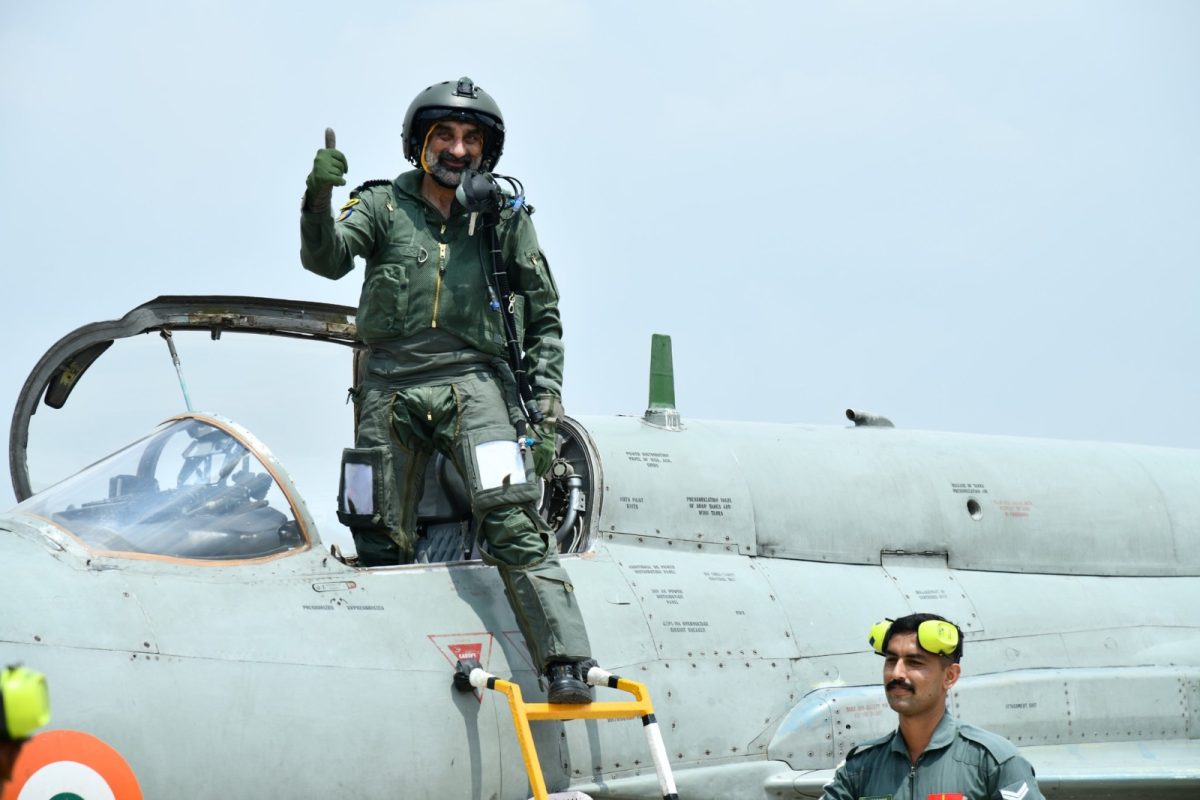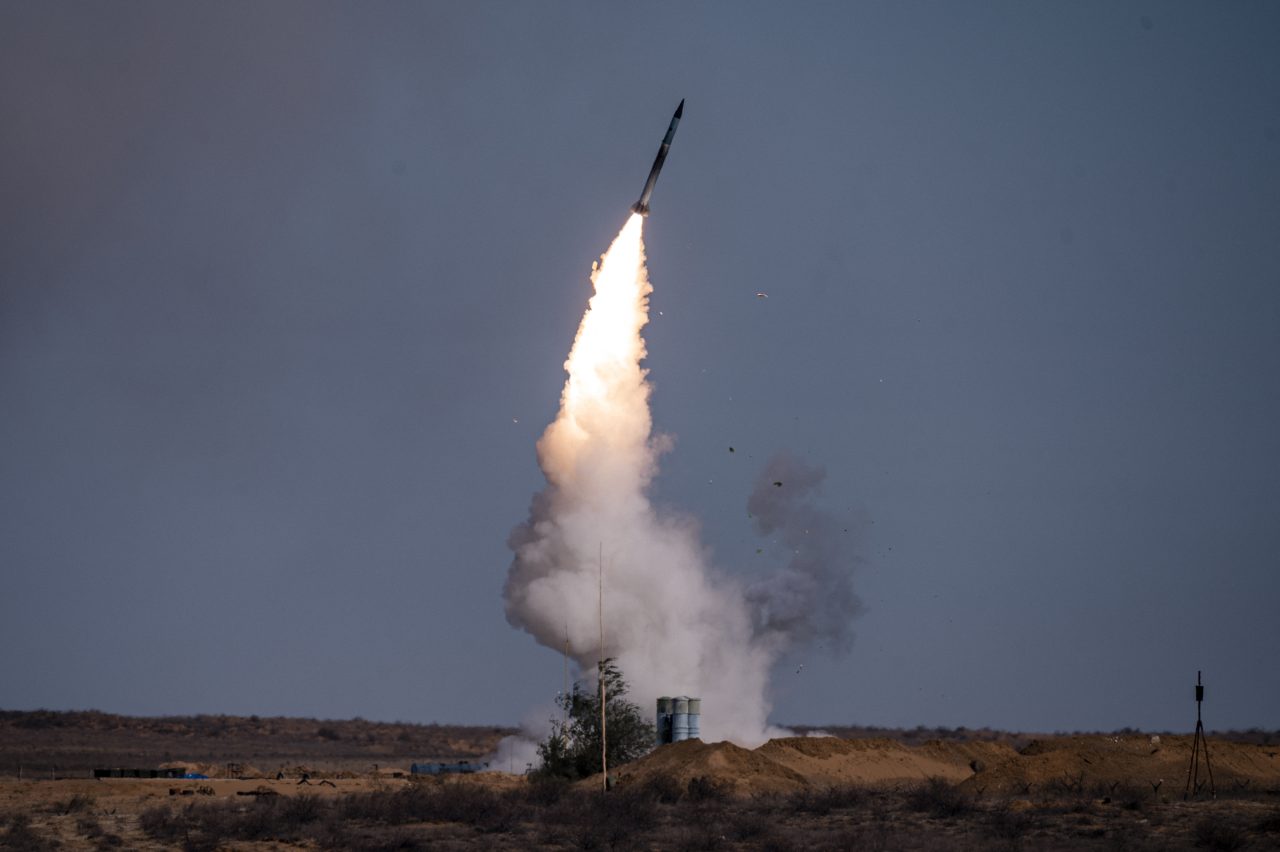IAF Chief Says India Focusing On Su-30 MKI, MRFA & Homegrown Jets To Boost Firepower; Remains Silent On Su-57, F-35

Commissioned into the fighter stream of the Indian Air Force on 21 December 1984, AP Singh PVSM AVSM took over as the 28th Chief of the Air Staff (CAS) on 30th September 2024.
He is an alumnus of the National Defence Academy, Defence Services Staff College, and National Defence College. He is a Qualified Flying Instructor and an Experimental Test Pilot with more than 5000 hours of service flying on a variety of fixed and rotary wing aircraft.
His operational tenures include being the Commanding Officer of a MiG-27 Sqn and Air Officer Commanding of a frontline air base.
As a test pilot, he led the MiG-29 Upgrade Project Management Team in Moscow, Russia. He was also the Project Director (Flight Test) at the National Flight Test Centre, looking after the flight testing of Tejas.
He has held staff appointments of Air Defence Commander at HQ South Western Air Command and Senior Air Staff Officer at HQ Eastern Air Command. He then took over as Air Officer Commanding-in-Chief, Central Air Command.
Before taking over as the 28th Chief of the Air Staff, the Air Officer held the appointment of Vice Chief of the Air Staff.
While acknowledging that the IAF faces many challenges at a time when the character of warfare is changing, he assured in an interview that India has a very credible and potent air force to give a befitting response to any contingency.
Q1. With aging aircraft, delayed modernization programmes, and shrinking squadrons, what is the state of the IAF’s operational readiness under your leadership, particularly against China and Pakistan?
Answer
1. I have been asked this question on numerous occasions. I have made it clear that there are no immediate or overnight solutions to this complex problem. The Indian Govt and IAF are working in close quarters to resolve this very challenge.
2. From an Acquisition perspective, we have processed certain cases, which include:
2.1. The contract for the procurement of 83 LCA Mk-IA, followed by another 97 LCA Mk-IA, shall give IAF a major boost.
2.2. Procurement of additional Su-30 MKI along with associated equipment.
2.3. IAF has processed a case for the procurement of Multi-Role Fighter Aircraft (MRFA), which is being progressed as per the provisions of DAP-2020.
3. Upgrade. From an upgrade perspective, we are processing an upgrade program for the existing Su-30 MKI fleet. This will be the first time an indigenous upgrade of any fleet is being planned. We have also undertaken operational capability upgrades like integration of SOR, induction of SOWs, and BVRAAMs like Astra. Induction, quick operationalization, and intelligent employment of S-400 have been a game-changer, as was witnessed in the recent operations.
4. Maintain. While we try to acquire new fighter aircraft and upgrade our existing fleet, there is an organisational push towards refining our maintenance philosophy and spare support. This will ensure the availability of present assets with a higher serviceability state, which, in turn, means more aircraft availability for operations.
5. Further, to retain the offensive edge, we are working with DRDO for the Design and Development of 4.5th & 5th-Gen fighters through LCA MK II and Advanced Medium Combat Aircraft (AMCA) projects. These projects are being pursued and reviewed regularly. I am confident that these platforms will be inducted by the next decade.
6. To maintain our competitive edge in the ever-changing landscape of modern warfare, we must undergo a transformative shift, not only in our technological capabilities but also in the development of our human capital.
I am of the firm belief that the sharpest sword is of limited significance if the swordsman wielding it is trained or unmotivated. Therefore, the human element continues to be our key focus area. We are striving to modernise our processes, training, and organisational structures.
We aim to be ‘Future Ready’ through the steps of ‘Now Ready’.

Q2. What are the lessons that the IAF has learnt from Operation Sindoor?
Answer
1. In the aftermath of the heinous Pakistan-sponsored terrorist attack, India refused to let evil thrive. We chose to act – to avenge the senseless slaughter of innocents. The Indian Armed Forces sprang into action, unleashing Op Sindoor at the very heart of terrorism. As the primary stakeholder in the operation, the Indian Air Force demonstrated the decisive impact of air power on military outcomes.
1.1. Political Will. The success of the operation was rooted in a clear political direction. When objectives are unambiguous and the political leadership empowers the military to act decisively, planning and execution become more efficient, allowing operations to achieve maximum effect without hesitation.
1.2. Jointness. Operation Sindoor exemplified the importance of synergy between the three services under the guidance of the CDS. A joint architecture enabled seamless information flow, effective decision-making, and real-time coordination of assets across the entire country, which effectively became a unified theatre of operations.
1.3. Primacy of Air Power. The operation reaffirmed the enduring relevance of offensive air power. The IAF’s ability to deliver precise, overwhelming firepower ensured that strategic objectives were met swiftly, reviving a capability last witnessed on such a scale during the 1971 war.
1.4. Conflict Termination. Within just four days, we achieved our operational objectives while the adversary’s forces remained intact and deployed. This highlights the effectiveness of focused planning, precision strikes, and decisive application of air power as tools for conflict termination, a lesson in achieving results quickly and efficiently in contrast to protracted conflicts elsewhere.
1.5. Operational Capability. Innovation and a careful balance of offensive and defensive measures allowed the IAF to deliver decisive outcomes. Indigenous offensive weapons and dense air defence systems ensured no critical IAF assets were lost, with even legacy systems such as the Pechora contributing to neutralising incoming threats.
1.6. Employment of Advanced Air Defence (S-400). For the first time, air defence was employed offensively. The S-400 denied the adversary freedom of action over its own territory, with tactics such as “Shoot and Scoot’ and rapid relocation disrupting the enemy’s ISR (Intelligence, Surveillance, and Reconnaissance) cycles and creating a significant operational advantage.

1.7. Counter-Drone Warfare. The adversary attempted to employ drones against IAF bases and assets, but these efforts failed. Through effective use of decoys, electronic jammers, and Counter-Unmanned Aerial Systems (CUAS), we neutralised these threats, highlighting the critical role of modern technology in protecting operational assets.
Operation Sindoor thus reinforced the importance of decisive political support, jointness, technological innovation, and precise application of air power, lessons that will guide the IAF in shaping future operations and multi-domain warfare capabilities.
Q3. What improvements, if any, does the IAF want in its procurement system in the ecosystem of “Make in India”/ “Atmanirbhar Bharat Abhiyan”?
Answer
1. The Ministry of Defence has initiated a comprehensive review of DAP-2020 to ensure that India’s defence procurement framework is better aligned with enabling policies such as Make in India and Atmanirbhar Bharat Abhiyan.
The aim is to enhance efficiency in the acquisition process while ensuring that the operational and capability development requirements of the Services are fully met, and that self-reliance in defence production is strengthened.
2. The Indian Air Force has actively contributed inputs to this review, highlighting areas for improvement in the procurement of complex aerospace systems. These include optimising Make, iDEX, and Technology Development Fund (TDF) schemes, and enabling participation by academia and other government agencies through the Capital Acquisition route, including collaborations with DRDO.
These recommendations are currently under consideration at the Ministry of Defence, and we are hopeful that their adoption will further strengthen India’s indigenous defence ecosystem while meeting the IAF’s operational requirements efficiently.
Q4. With air power increasingly becoming heterogeneous in nature and no longer built solely for crewed aircraft, what is the IAF’s strength in terms of drones, missiles, and Artificial Intelligence?
Answer
1. Air power today is increasingly heterogeneous, combining manned platforms with unmanned systems, missiles, and artificial intelligence to achieve operational superiority. Recent conflicts have highlighted the utility of drones and missiles in specific, well-defined scenarios, such as tactical strikes, reconnaissance, or SEAD missions.
However, they do not yet replace the full spectrum of capabilities offered by manned aircraft. Accordingly, the IAF follows a philosophy where unmanned platforms complement, rather than substitute, manned aircraft.
2. The IAF’s strength in unmanned systems is steadily growing. We have inducted MQ-9B Sky/Sea Guardian RPAs, are acquiring Medium Altitude Long Endurance (MALE) UAVs and are actively developing indigenous swarm drones. In addition, indigenous combat-capable platforms such as the Ghatak UCAV are under development to extend our offensive capabilities.
3. In missile technology, the IAF possesses a diverse arsenal of air-launched precision weapons, both air-to-surface and air-to-air, complemented by advanced surface-to-air systems such as the long-range S-400.
4. Artificial Intelligence (AI) is another key enabler. Our AI-powered Integrated Air Command and Control System (IACCS) supports real-time threat assessment, interception guidance, and pilot identification, while also enhancing operational efficiency through predictive analysis, intelligent document management, and generative AI for intelligence processing.
In fleet management, Al predicts engine failures, enables predictive maintenance, and supports non-invasive inspections via drones. For pilot training and operational safety, Al provides personalized feedback, analyzes cockpit voice recordings, and generates real-time alerts.
5. The IAF is also fostering collaboration with academia and industry on AI-driven innovation, including weather forecasting and sensor fusion, ensuring that unmanned and manned platforms operate seamlessly in a networked, multi-domain environment. These integrated capabilities are central to the IAF’s vision of a technologically advanced, future-ready air force.
Q5. Is the IAF attracting adequate, skilled, and motivated manpower into its fold?
Answer
1. The Indian Air Force places great emphasis on attracting skilled and motivated manpower, and our selection processes are designed accordingly. Entry-level qualifications and recruitment procedures for officers and airmen have been meticulously developed and vetted at multiple levels within the IAF to ensure alignment with organisational requirements.
These standards have proven effective in selecting candidates who possess the requisite skill sets, technical aptitude, and motivation to serve in a technologically advanced force. The IAF’s reputation as a technology intensive service makes it one of the most sought-after arms of the armed forces.
2. In line with the Digital India initiative, the IAF was the first service to conduct online examinations for airmen recruitment, ensuring transparency, efficiency, and wider accessibility. To further enhance demographic representation, particularly from states with lower response rates, we have introduced state-wise allocation of vacancies.
Additionally, intensified outreach campaigns and recruitment rallies conducted by the Central Airmen Selection Board (CASB) have generated overwhelming interest, reflecting the enthusiasm and commitment of today’s youth to join the IAF.
3. Through these measures, the IAF continues to attract talented and motivated individuals who are ready to contribute to our mission of safeguarding the nation.
- Questions and Answers
- Opinion
- Motivational and Inspiring Story
- Technology
- Live and Let live
- Focus
- Geopolitics
- Military-Arms/Equipment
- Sicherheit
- Economy
- Beasts of Nations
- Machine Tools-The “Mother Industry”
- Art
- Causes
- Crafts
- Dance
- Drinks
- Film/Movie
- Fitness
- Food
- Spiele
- Gardening
- Health
- Startseite
- Literature
- Music
- Networking
- Andere
- Party
- Religion
- Shopping
- Sports
- Theater
- Health and Wellness
- News
- Culture

